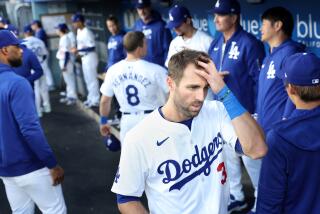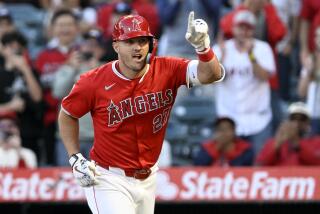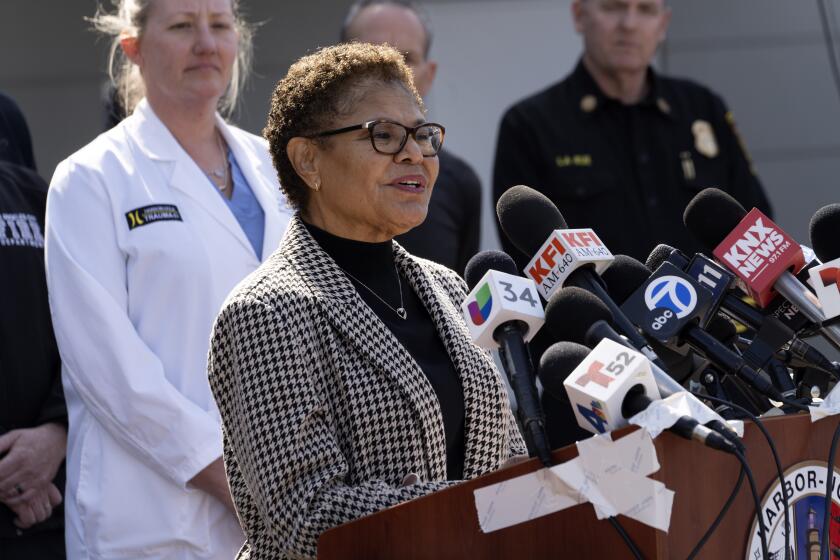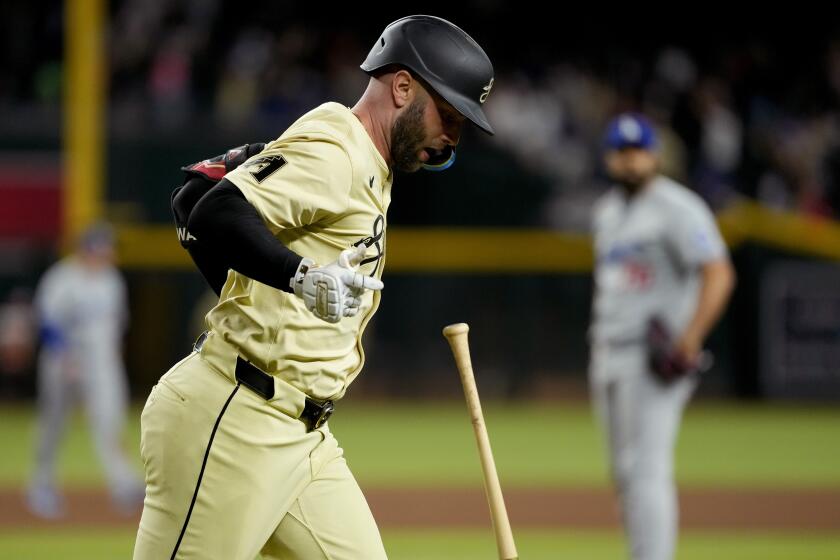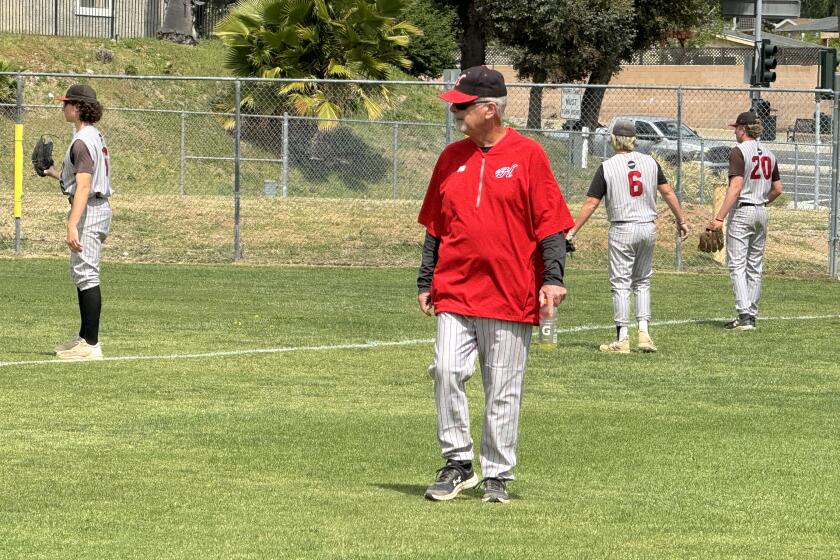Runs, Hits and an Era
Players in the South County Jasper dugout tried to conjure an era-appropriate term as they exhorted batsman Mike “Professor” Ballen to drive home his teammates at first and third base.
“All right, Professor, two horses in the barn!” yelled Jasper captain Gary “Pops” Cooper. “Two roosters in the henhouse!” offered another teammate. “Two fleas on the dog!” cried a third.
For the record:
12:00 a.m. June 2, 2005 For The Record
Los Angeles Times Thursday June 02, 2005 Home Edition Main News Part A Page 2 National Desk 1 inches; 38 words Type of Material: Correction
Vintage baseball -- A photo caption in Monday’s Section A with an article about teams that play baseball according to the rules and customs of the 19th century identified the player shown, Gary “Pops” Cooper, as Mike Ballen.
The expression “two ducks on the pond,” sometimes used by present-day broadcasters, clearly wouldn’t do -- not for this group of “ballists” intent on re-creating not only the look and play but even the argot of “base ball” as practiced during the presidency of Grover Cleveland.
“Striker to the line,” called umpire Jim Saeger, black top hat bobbing and gold pocket-watch chain glinting in the sunlight of a recent Sunday morning. Ballen, with his blousy lace-up shirt, long stockings and trousers that tie below the knee, stepped up to home base, hefting his thick-handled replica bat.
“How would you like your pitches?” the umpire, as required by the old rules, asked.
“Low,” Ballen replied.
“Low strikes,” the ump informed Steve “Cappy” Gazay, hurler for the San Jose Dukes.
Gazay delivered as instructed, a pitch between the belt and knees. With an “oomph,” Ballen lofted a high single to left field, allowing both runners to leg it home for a 12-5 Jasper lead.
When the game was over and the clubs had cheered “huzzah!” for each other, the unbeaten Jaspers had a 13-10 victory, stretching their winning streak to five games.
Which meant the Duke losing streak was now at five.
The two clubs are the only members of Bay Area Vintage Base Ball, which began its inaugural season last month. The organization is the only one in California devoted to playing the game according to the rules and customs of the 19th century.
Its players welcome the old game as an alternative to frequently quarrelsome adult baseball and softball leagues. It also represents a kind of purity that is lost in the din of the modern professional game, with its high-tech equipment, tantrum-prone millionaire players and rock-concert sound systems.
The vintage game, said author and former New York Yankee pitcher Jim Bouton, “is the wave of the future. It has all the things that people love most about baseball, and none of the things they hate.”
Vintage baseball -- “base ball,” as it was called 125 years ago -- has been a fixture in the East and upper Midwest for as long as two decades. Members of nearly 200 amateur clubs can be found on weekends running sand-filled bases in knickers and pillbox hats and trying to field hardballs with gloves no thicker than a gardener’s -- or with no gloves at all.
Some clubs are affiliated with local historical museums. Others were started by Civil War reenactment groups, which emulate Union and Confederate soldiers’ recreational activities.
But there is a crucial difference between ballists and soldier-reenactors: On the base ball diamond, the competition isn’t scripted, and it’s often intense. The equivalent would be Civil War reenactors firing live musket balls at one another’s potbellies, with the victory awarded to those left standing.
This combination of theater and real-time competition, said Ballen, a 56-year-old professor of liberal studies at Santa Clara University, makes for a particularly resonant form of time travel. Caught up in the action, a spectator at a Duke-Jasper game might have thought he’d hyper-spaced back to 1886 (if he could ignore the line of SUVs parked along Hamann Park and the guy playing Frisbee with his dog in the far reaches of left field).
The antique game holds many points of allure for those who play it. It has a gentlemanly code: The sole umpire may not be argued with; spitting and cursing are fineable offenses. It has arcane rules: A foul tip caught by the “behind” -- that is, the catcher -- is an out regardless of the pitch count, and quick-pitching and the hidden-ball trick are legal. It presents the challenge of competing without modern equipment: no shin guards, batting helmets or padded mitt.
Gazay, a 41-year-old software salesman for Oracle Corp., saw an ESPN broadcast of a vintage game last year and contacted his brother-in-law, Cooper, a member of a large baseball-playing clan in the rural south of Santa Clara County, about organizing a league.
Cooper, a 51-year-old highway safety worker and former semipro player, immediately saw vintage base ball as something he could do with his grown son Matt. He also was attracted to it, he said, because he’d gotten “a little tired of in-your-face baseball, with teams ragging at each other and a lot of bad vibe.”
By early this year, Gazay and Cooper had recruited enough players -- professional men, educators, businessmen and workingmen -- to field two teams.
One player, Norm “Lefty” Robbins, the 35-year-old principal of a San Jose junior high school, responded to an item Gazay had placed in a newspaper. “I thought, what a cool thing,” he said as he prepared to start the recent game as the Duke catcher.
In vintage base ball, its advocates like to say, there are no ho-hum plays. “You’ll see the easiest play get flubbed,” said Greg Martin, founder of Hartford, Conn.-based Vintage Base Ball Factory, which supplies many teams with uniforms and equipment. Martin, who plays for the vintage Hartford Senators, said vintage ballists must learn caution. “It’s OK to let a hard-hit line drive fall in for a base hit. You don’t have the equipment to stop the ball. Plays are really routine in the modern game, but for the first 30 or 40 years of the game, there was no such thing.”
Bouton became involved in vintage ball last year after he helped turn up a Pittsfield, Mass., document from 1791 that forbade playing “at any game called Wicket, Cricket, Baseball, Football, Cat, Fives or any other game or games with balls” within 80 yards of the town meetinghouse. This so-called Broken Window Bylaw is the earliest written reference to baseball, obliterating, among other things, the already discredited notion that Abner Doubleday invented the game in Cooperstown, N.Y., in 1839.
Bouton, who wrote the classic baseball book “Ball Four,” tried in vain to persuade Pittsfield officials to restore a 19th century ballpark where the game was played, an effort he chronicled in his most recent book, the self-published “Foul Ball.”
Some of the clubs play by the earliest rules, dating from the 1850s to the 1870s, which dictate that the hurler must “pitch” the ball rather than “throw” it -- that is, lob the ball underhand, much like in modern slow-pitch softball, except that the hurler isn’t permitted to swing his arm back before delivering the ball. The hurling motion has to start with his pitching arm perpendicular to the ground.
“In the old days, the idea that the pitcher was in combat with the batter was not important,” explained baseball historian John Thorn. “The pitcher was there to serve the ball up, to put it in play. Fielding was regarded as the most elegant and beautiful aspect of the game.”
Many other clubs, perhaps a third, have opted for rules devised in the 1880s, when the game had evolved to allow overhand pitching.
Bay Area Vintage Base Ball uses an 1886 rule book. A foul ball can be caught on one bounce for an out. Seven balls are required to walk a batsman, and three to strike him out. A batsman struck by a ball does not earn a trip to first base.
“We think the 1880s ball is the one that’s going to make vintage baseball popular across the country,” Gazay said. “There’s enough differences to make it interesting, but it’s enough like today’s game that people recognize it as baseball.”
The biggest reason Gazay opted for 1880s play for the Bay Area league, he said, was that players were wearing rudimentary gloves by that time. Still, the replica leather gloves the Bay Area clubs use are only about a quarter of an inch thick. One player each on the Dukes and the Jaspers wears a finger splint for an injury suffered while trying to stop a hard-hit ball. In the most recent game, Jasper first baseman Allan “Big Train” Keen, the 45-year-old manager of a traffic safety company, was struck hard on the side of his glove hand by a throw from his catcher. He left the game doubled over in pain.
Gazay has had a few problems keeping the Dukes and Jaspers in the spirit of the vintage game. At the beginning of the season, he distributed a list of antique terms -- “ace” for “run scored,” “skyball” for “pop-up,” “crank” for “fan” -- but in the heat of competition, players often forget to use them.
He’s also had little luck persuading “behinds” to crouch 15 or 20 feet to the rear of batsmen, as catchers of old did, given their flimsy chest protectors, antique face masks and tiny gloves. “My guys insist on getting right behind the batter,” Gazay said, “and I tell them, ‘You’re going to get killed.’ ”
Like many other vintage clubs, the Dukes are based on and named after a local club that existed more than a century ago (the Jaspers have no such pedigree; they’re named after a kind of quartz that’s found locally only in the Morgan Hill-Gilroy area).
The teams’ uniforms, which feature lace-up shirt fronts, are fashioned after those favored by American Assn. teams in the 1880s. They’re more akin to modern baseball dress than earlier versions, which were based on mid-19th century firemen’s uniforms, according to historian Thorn. Not only were many early base ball clubs formed at fire stations, but the firemen’s uniforms had interchangeable, shield-shaped dickeys that differentiated one fire company from another and provided differentiation among the ball clubs.
The players and fans have embraced the gentlemanly etiquette of vintage base ball. A good play by the opposition is applauded. The umpire is referred to as “sir.” If an umpire cannot make a call because he was unable to see the play, a decision is made by “gentlemen’s agreement.” The players involved -- and even spectators -- are expected to tell the umpire the truth about what happened.
In the recent game, for example, a Duke runner was picked off first base by the hurler, but it was generally agreed that the latter had first made an improper motion to the batter, so the pickoff was nullified.
Evidence exists that in much of 19th century base ball, gentlemanly etiquette was honored as much in the breach as in the observance. In the 1840s and ‘50s, said Thorn, most clubs were composed of white-collar workers and professionals. By the 1860s, however, many clubs had been formed by workingmen not necessarily enamored of the gentlemanly ethic. Moreover, playing for money -- previously strictly forbidden -- became common. Once financial gain was involved, “it was more important for these workingmen’s clubs to win than to just have exercise and a banquet afterward,” Thorn said.
Which is not to say that winning is of no concern to today’s vintage clubs. Several Duke players were noticeably downcast after dropping their fifth straight to the Jaspers.
Beating the South County club may be Duke captain Gazay’s most pressing challenge, but his biggest is recruiting enough players to form additional clubs. The Dukes and Jaspers face off every two weeks until October. Understandably, they’re getting a little weary of playing only each other. Gazay hopes to add a third club to the league by year’s end and looks forward to clubs forming in Southern California so that inter-regional play is possible.
“I specifically want to go after Little League dads -- you know, guys who really love the game -- or maybe guys who played in adult leagues but got tired of all the drinking and fights,” he said. Martin, of Vintage Base Ball Factory, has helped as many as 40 clubs get started. He looks forward to the day vintage leagues exist throughout the country, playing by more or less standardized rules. The best teams would compete each year in a “Vintage World Series” in a replica 19th century ballpark he would like to see built in Hartford, Conn.
“Vintage base ball is going through an evolution like the game did 125 years ago, and the time might be right to streamline things to make it more attractive to new clubs,” he said. “I’d like to see every single town in the country have their own team, which is really how it was all those years ago.”
*
(BEGIN TEXT OF INFOBOX)
The old ball game
Some differences between present-day baseball rules and 1886 rules:
Now: Pitcher may pitch to a batter however he pleases.
Then: Batsman, through the umpire, calls for high or low pitches, or both.
Now: Four balls is a walk.
Then: Seven balls is a walk.
Now: Hit batter is awarded first base.
Then: A pitch that hits the batsman is counted only as one ball.
Now: Foul tip caught by catcher is an out only on the third strike.
Then: Caught foul tip is an out any time.
Now: Foul ball is an out if caught on the fly.
Then: Foul ball is an out if caught on the fly or on the first bounce.
Now: Pitcher must pitch from rubber on mound.
Then: Hurler pitches from a flat, 4-by-6-foot hurler’s box.
Now: Pitcher must wait until batter is ready before pitching.
Then: Hurler may pitch any time he is in his hurler’s box (quick-pitching is legal).
Now: Pitcher must have ball if he puts foot on the rubber.
Then: Hurler may be in his box without ball (thus enabling infielders to play the “hidden-ball trick” on a baserunner).
Source: Spalding’s Official Baseball Guide, 1886
More to Read
Get our high school sports newsletter
Prep Rally is devoted to the SoCal high school sports experience, bringing you scores, stories and a behind-the-scenes look at what makes prep sports so popular.
You may occasionally receive promotional content from the Los Angeles Times.
